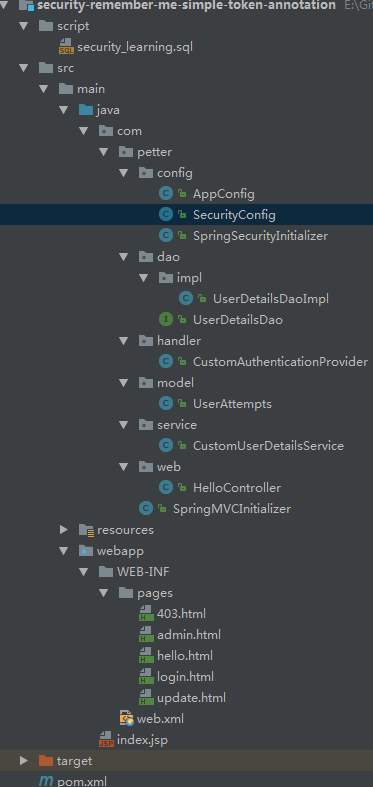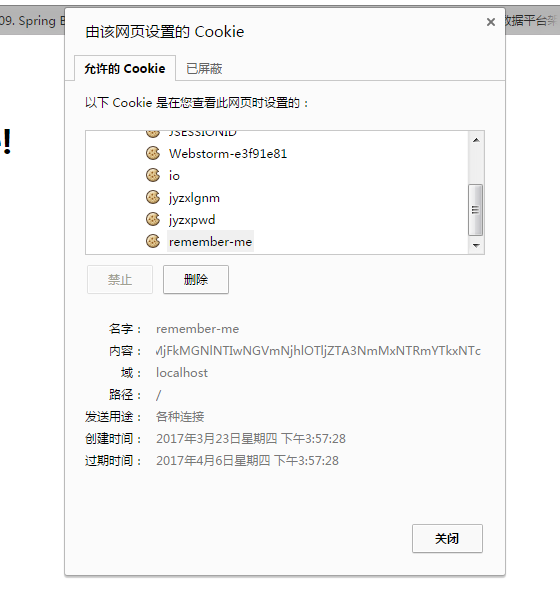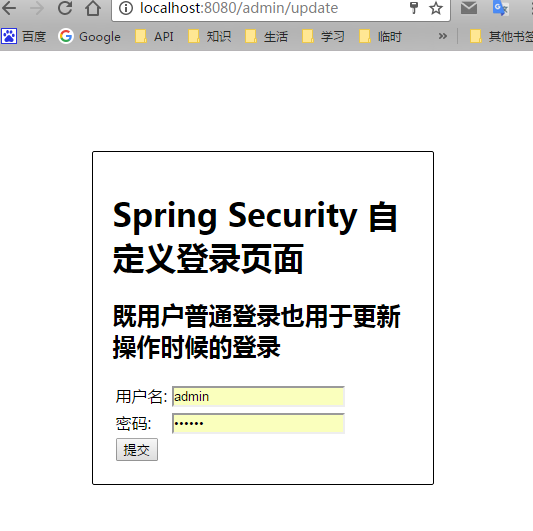记住我功能,相信大家在一些网站已经用过,一些安全要求不高的都可以使用这个功能,方便快捷。
spring security针对该功能有两种实现方式,一种是简单的使用加密来保证基于 cookie 的 token 的安全,另一种是通过数据库或其它持久化存储机制来保存生成的 token。
下面是基于简单加密 token 的方法的实现,基于前篇的限制登录次数的功能之上加入remember me功能
项目结构如下:

基本的结构没有变化,主要在于一些类的修改和配置。
一、修改SecurityConfig配置文件
package com.petter.config; import com.petter.handler.CustomAuthenticationProvider; import com.petter.service.CustomUserDetailsService; import org.springframework.context.annotation.Bean; import org.springframework.context.annotation.Configuration; import org.springframework.security.config.annotation.authentication.builders.AuthenticationManagerBuilder; import org.springframework.security.config.annotation.web.builders.HttpSecurity; import org.springframework.security.config.annotation.web.configuration.EnableWebSecurity; import org.springframework.security.config.annotation.web.configuration.WebSecurityConfigurerAdapter; import org.springframework.security.core.userdetails.UserDetailsService; import org.springframework.security.web.authentication.SavedRequestAwareAuthenticationSuccessHandler; import javax.annotation.Resource; /** * 相当于spring-security.xml中的配置 * @author hongxf * @since 2017-03-08 9:30 */ @Configuration @EnableWebSecurity public class SecurityConfig extends WebSecurityConfigurerAdapter { @Resource private CustomAuthenticationProvider authenticationProvider; @Resource private CustomUserDetailsService userDetailsService; @Override protected void configure(AuthenticationManagerBuilder auth) throws Exception { auth.authenticationProvider(authenticationProvider); } /** * 配置权限要求 * 采用注解方式,默认开启csrf * @param http * @throws Exception */ @Override protected void configure(HttpSecurity http) throws Exception { http.authorizeRequests() .antMatchers("/admin/**").hasRole("ADMIN") .antMatchers("/dba/**").hasAnyRole("ADMIN", "DBA") .and() .formLogin().successHandler(savedRequestAwareAuthenticationSuccessHandler()) .loginPage("/login") //指定自定义登录页 .failureUrl("/login?error") //登录失败的跳转路径 .loginProcessingUrl("/auth/login_check") //指定了登录的form表单提交的路径,需与表单的action值保存一致,默认是login .usernameParameter("user-name").passwordParameter("pwd") .and() .logout().logoutSuccessUrl("/login?logout") .and() .exceptionHandling().accessDeniedPage("/403") .and() .csrf() .and() .rememberMe().rememberMeParameter("remember-me") //其实默认就是remember-me,这里可以指定更换 .tokenValiditySeconds(1209600) .key("hongxf"); } //使用remember-me必须指定UserDetailsService @Override protected UserDetailsService userDetailsService() { return userDetailsService; } /** * 这里是登录成功以后的处理逻辑 * 设置目标地址参数为targetUrl * /auth/login_check?targetUrl=/admin/update * 这个地址就会被解析跳转到/admin/update,否则就是默认页面 * * 本示例中访问update页面时候会判断用户是手动登录还是remember-me登录的 * 如果是remember-me登录的则会跳转到登录页面进行手动登录再跳转 * @return */ @Bean public SavedRequestAwareAuthenticationSuccessHandler savedRequestAwareAuthenticationSuccessHandler() { SavedRequestAwareAuthenticationSuccessHandler auth = new SavedRequestAwareAuthenticationSuccessHandler(); auth.setTargetUrlParameter("targetUrl"); return auth; } }
这里需要指出几点:
1、使用remember-me功能必须指定UserDetailsService
2、修改登录成功以后的逻辑,具体见注释
3、添加remember me的配置,key("hongxf"),这里的key用于加密,可以进行指定
二、修改admin.html,添加
<div sec:authorize="isRememberMe()"> <h2>该用户是通过remember me cookies登录的</h2> </div> <div sec:authorize="isFullyAuthenticated()"> <h2>该用户是通过输入用户名和密码登录的</h2> </div>
用于展示
三、修改登录页面login.html
form表单需要进行相应的修改
<form name='loginForm' th:action="@{/auth/login_check(targetUrl=${session.targetUrl})}" method='POST'> <table> <tr> <td>用户名:</td> <td><input type='text' name='user-name' /></td> </tr> <tr> <td>密码:</td> <td><input type='password' name='pwd' /></td> </tr> <!-- 如果是进行更新操作跳转过来的页面则不显示记住我 --> <div th:if="${loginUpdate} eq null"> <tr> <td></td> <td>记住我: <input type="checkbox" name="remember-me" /></td> </tr> </div> <tr> <td colspan='2'> <input type="submit" value="提交" /> </td> </tr> </table> </form>
注意action的值,首先请求路径是/auth/login_check,与SecurityConfig配置的loginProcessingUrl保持一致
/auth/login_check(targetUrl=${session.targetUrl})会被解析成/auth/login_check?targetUrl=XXX 其中targetUrl的从session中获取
四、编写update.html页面
<!DOCTYPE html> <html lang="en"> <head> <meta charset="UTF-8"> <title>update</title> </head> <body> <h1>Title : 更新页面</h1> <h1>只有通过用户名和密码登录的用户才允许进入这个页面,remember me登录的用户不允许,防止被盗用cookie</h1> <h2>更新账号信息</h2> </body> </html>
五、修改HelloController类
package com.petter.web; import org.springframework.security.authentication.AnonymousAuthenticationToken; import org.springframework.security.authentication.BadCredentialsException; import org.springframework.security.authentication.LockedException; import org.springframework.security.authentication.RememberMeAuthenticationToken; import org.springframework.security.core.Authentication; import org.springframework.security.core.context.SecurityContextHolder; import org.springframework.security.core.userdetails.UserDetails; import org.springframework.stereotype.Controller; import org.springframework.util.StringUtils; import org.springframework.web.bind.annotation.RequestMapping; import org.springframework.web.bind.annotation.RequestMethod; import org.springframework.web.bind.annotation.RequestParam; import org.springframework.web.servlet.ModelAndView; import javax.servlet.http.HttpServletRequest; import javax.servlet.http.HttpSession; /** * @author hongxf * @since 2017-03-08 9:29 */ @Controller public class HelloController { @RequestMapping(value = { "/", "/welcome" }, method = RequestMethod.GET) public ModelAndView welcomePage() { ModelAndView model = new ModelAndView(); model.addObject("title", "Spring Security Hello World"); model.addObject("message", "This is welcome page!"); model.setViewName("hello"); return model; } @RequestMapping(value = "/admin", method = RequestMethod.GET) public ModelAndView adminPage() { ModelAndView model = new ModelAndView(); model.addObject("title", "Spring Security Hello World"); model.addObject("message", "This is protected page - Admin Page!"); model.setViewName("admin"); return model; } @RequestMapping(value = "/dba", method = RequestMethod.GET) public ModelAndView dbaPage() { ModelAndView model = new ModelAndView(); model.addObject("title", "Spring Security Hello World"); model.addObject("message", "This is protected page - Database Page!"); model.setViewName("admin"); return model; } /** * 登录页面只允许使用密码登录 * 如果用户通过remember me的cookie登录则跳转到登录页面输入密码 * 为了避免盗用remember me cookie 来更新信息 */ @RequestMapping(value = "/admin/update", method = RequestMethod.GET) public ModelAndView updatePage(HttpServletRequest request) { ModelAndView model = new ModelAndView(); if (isRememberMeAuthenticated()) { //把targetUrl放入session中,登录页面使用${session.targetUrl}获取 setRememberMeTargetUrlToSession(request); //跳转到登录页面 model.addObject("loginUpdate", true); model.setViewName("login"); } else { model.setViewName("update"); } return model; } /** * 判断用户是不是通过remember me方式登录,参考 * org.springframework.security.authentication.AuthenticationTrustResolverImpl */ private boolean isRememberMeAuthenticated() { Authentication authentication = SecurityContextHolder.getContext().getAuthentication(); return authentication != null && RememberMeAuthenticationToken.class.isAssignableFrom(authentication.getClass()); } /** * 保存请求的页面targetUrl到session中 */ private void setRememberMeTargetUrlToSession(HttpServletRequest request){ HttpSession session = request.getSession(false); if(session != null){ session.setAttribute("targetUrl", request.getRequestURI()); } } //获取session存储的SPRING_SECURITY_LAST_EXCEPTION的值,自定义错误信息 @RequestMapping(value = "/login", method = RequestMethod.GET) public ModelAndView login( @RequestParam(value = "error", required = false) String error, @RequestParam(value = "logout", required = false) String logout, HttpServletRequest request) { ModelAndView model = new ModelAndView(); if (error != null) { model.addObject("error", getErrorMessage(request, "SPRING_SECURITY_LAST_EXCEPTION")); //在update的登录页面上,判断targetUrl是否有值,没有则显示记住我,有则不显示 String targetUrl = getRememberMeTargetUrlFromSession(request); System.out.println(targetUrl); if(StringUtils.hasText(targetUrl)){ model.addObject("loginUpdate", true); } } if (logout != null) { model.addObject("msg", "你已经成功退出"); } model.setViewName("login"); return model; } /** * 从session中获取targetUrl */ private String getRememberMeTargetUrlFromSession(HttpServletRequest request){ String targetUrl = ""; HttpSession session = request.getSession(false); if(session != null){ targetUrl = session.getAttribute("targetUrl") == null ? "" :session.getAttribute("targetUrl").toString(); } return targetUrl; } //自定义错误类型 private String getErrorMessage(HttpServletRequest request, String key){ Exception exception = (Exception) request.getSession().getAttribute(key); String error; if (exception instanceof BadCredentialsException) { error = "不正确的用户名或密码"; }else if(exception instanceof LockedException) { error = exception.getMessage(); }else{ error = "不正确的用户名或密码"; } return error; } @RequestMapping(value = "/403", method = RequestMethod.GET) public ModelAndView accessDenied() { ModelAndView model = new ModelAndView(); //检查用户是否已经登录 Authentication auth = SecurityContextHolder.getContext().getAuthentication(); if (!(auth instanceof AnonymousAuthenticationToken)) { UserDetails userDetail = (UserDetails) auth.getPrincipal(); model.addObject("username", userDetail.getUsername()); } model.setViewName("403"); return model; } }
六、进行测试
启动应用,访问http://localhost:8080/admin 会跳转到登录页

输入正确的用户名和密码,勾选记住我,登录成功进入admin页面


可以看到remember-me的值以及失效日期
想要尝试记住我免登录功能,重启应用,访问http://localhost:8080/admin ,可以看到


注意上面的访问地址就是http://localhost:8080/admin/update 只是返回的是登录页内容,并且隐藏了记住我选项,查看页面源代码,可以看到
<form name='loginForm' action="/auth/login_check?targetUrl=/admin/update" method='POST'>
当输入争取的用户名和密码时候security会根据targetUrl的值跳转到之前访问的页面
